Royal Palace Museum

The Royal Palace Museum, also known as Haw Kham or “Golden Hall”, is a prominent cultural and historical site in Luang Prabang, Laos. The museum combines traditional Lao architectural styles with French Beaux-Arts influences, creating a unique and elegant structure. The museum offers a fascinating glimpse into the royal history and heritage of Laos.

Royal Palace Museum (Cre: Sofitel Luang Prabang)
The Royal Palace was constructed in 1904 as the official residence for King Sisavang Vong and his family. After the death of King Sisavang Vong, the crown Prince Savang Vatthana and his family were the last to occupy the palace. After the 1975 revolution, which marked the end of the Lao monarchy, the palace was converted into a museum.
Today, it preserves a wealth of historical and cultural artifacts, providing insight into the royal family’s life and the broader history of Laos. The design reflects a blend of traditional Lao architecture and French colonial elements, symbolizing the merging of Lao culture with Western influences.
Entering the palace, you will be greeted by a lovely garden with a fantastic structure, containing multiple trees and a lotus pond. There is also a bronze statue of King Sisavang Vong here, as well as a couple of cannon mortars.
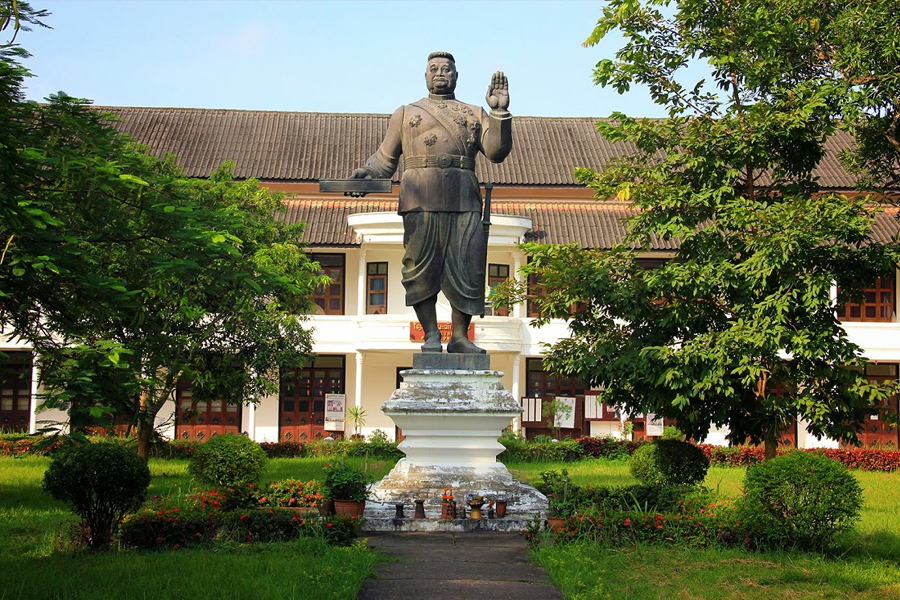
Statue of King Sisavang Vong in the Royal Palace Museum Complex (Cre: bestpricetravel)
Within the palace compound, there are several notable buildings, including the Royal Barge Shelter, a conference hall, and Haw Pha Bang, an ornate pavilion housing the standing Buddha statue called Prabang. In the past, the Prabang statue and many other religious artifacts were kept in the front wing of the palace.
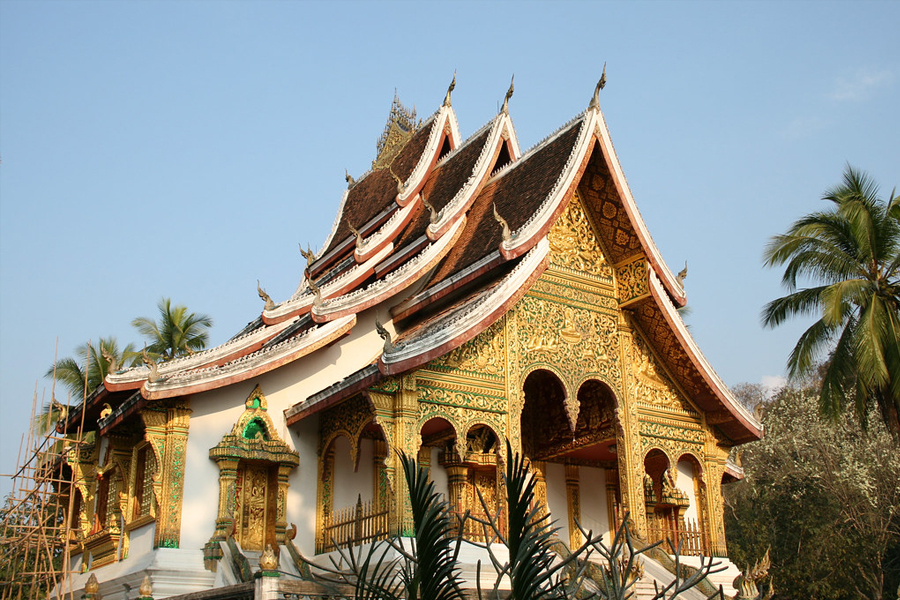
Haw Pha Bang in the Royal Palace Museum Complex (Cre: Cifor)
The compound also features a building that holds the royal car collection, a small assortment of mostly American cars from the 1950s to the 1970s. Behind the garages, there is another building with a gallery for rotating exhibitions.
Inside the Royal Palace Museum, everything is carefully kept as it was. The palace is very luxurious, with many rooms including council rooms, reception rooms, collection rooms, and living rooms. The museum also has many old paintings and historical photos, helping visitors understand the history of Laos. The ceilings and many objects are covered in gold, showing the richness of this former royal palace.
The palace building itself can be divided into three main parts: the front wing, which includes reception areas; the throne hall in the middle; and the back wing, which was once the residential area.

Interior Art inside Royal Palace Museum (Cre: bestpricetravel)
The King’s reception hall, located to the right of the entrance, now displays busts and paintings of the Lao monarchy, along with two large gilded and lacquered Ramayana screens. The walls are adorned with murals depicting traditional Lao lifestyles, painted by a French artist in the 1930s.
The room next to the King’s reception hall houses a collection of the palace’s most prized art, including a cast of the esteemed Pha Bang Buddha statue made from gold, silver, and bronze. The most valuable item in the Royal Palace Museum is the Prabang Buddha statue. This national treasure of Laos is made of gold, weighs 48 kg, and stands 83 cm high. During the Lao New Year festival, the statue is taken to Wat Xieng Thong for a special ritual where it is cleaned with water and flowers.
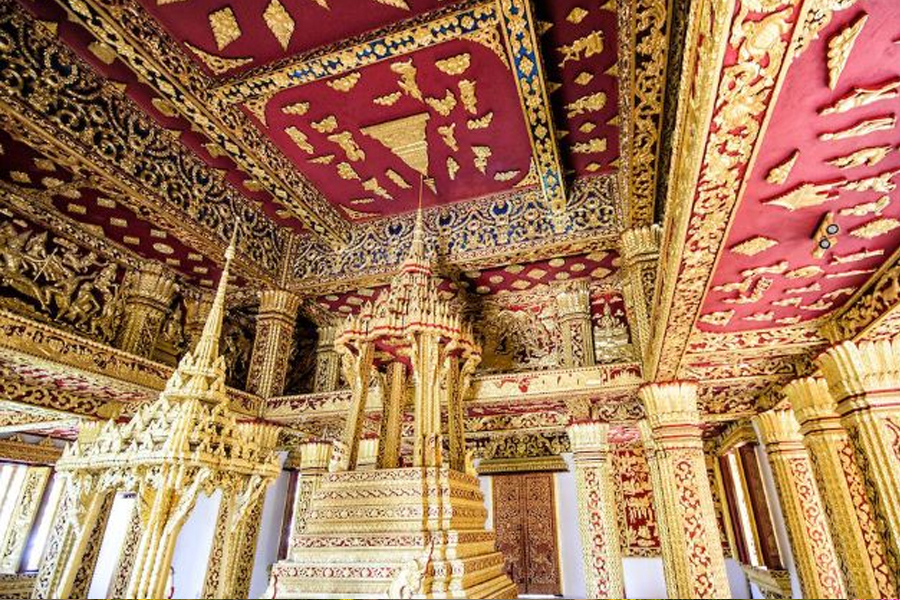
The shrine containing the Buddha image (Cre: Go Laos Tours)
On the left side of the entrance hall, the former secretary’s reception area now showcases gifts from various heads of state to the Lao monarchy, categorized into groups from "socialist" and "capitalist" countries.
The room to the left of the secretary’s reception was once the Queen’s reception room. It now displays paintings of King Savang Vatthana, Queen Khamphoui, and Crown Prince Vong Savang, painted by a Russian artist in 1967. This room also features friendship flags from China and Vietnam, as well as replicas of sculptures from the National Museum in New Delhi.
The throne room, used for meetings and special occasions, holds a throne designed as a seat placed on the back of an elephant, carved in the shape of an eagle. This room was where important decisions were made.
The throne hall serves as a connector between the reception wing and the residential wing, where the royal family’s bedrooms and living quarters were located. The walls of the throne hall are adorned with mirrored tile mosaics, similar to those found in Wat Xieng Thong, the town’s oldest temple. Inside the throne hall, you can see the thrones of the king and queen, the king’s elephant chair, and glass cases displaying numerous crystal Buddha images that were moved from Wat That Makmo.
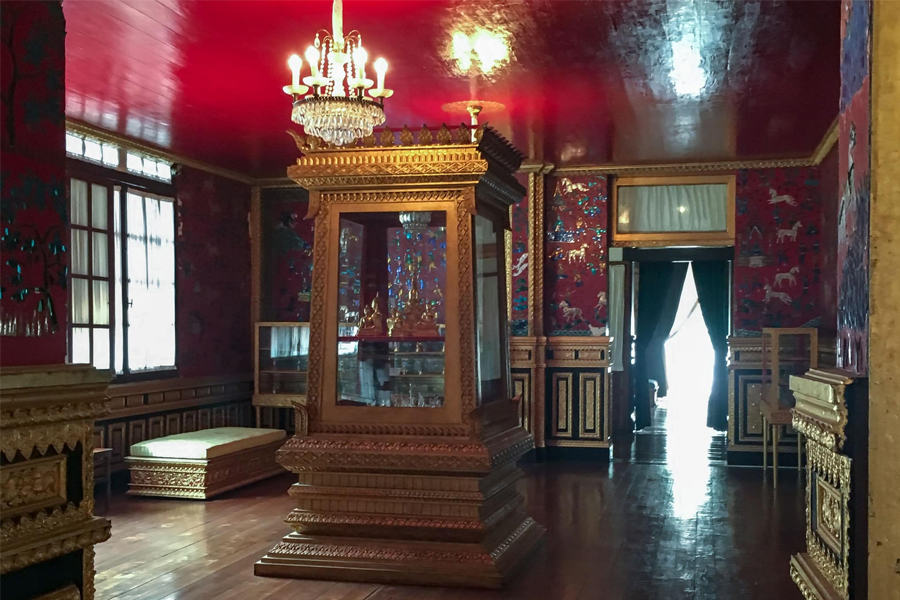
Inside the Royal Palace Museum (Cre: 7toucans)
The back wing of the Royal Palace Museum was the residential area for the royal family. It includes bedrooms, a dining room, a library, and an area showcasing music and dance exhibits with Lao classical instruments and masks. This section of the palace has been preserved largely as it was in 1975, before the royal family departed, providing a glimpse into the everyday life of the Lao royals.
The best time to visit the Royal Palace Museum in Luang Prabang is during the dry season, which runs from November to March. During these months, the weather is cool and pleasant, making it ideal for exploring the museum and other attractions in the city.

How to get to the Royal Palace Museum (Cre: Planet Janet Travels)
The Royal Palace Museum is centrally located in Luang Prabang, making it easily accessible. Given its central location, the museum is easily accessible on foot or by bicycle for those staying in or near the city center. You can take a taxi or tuk-tuk to the museum if you’re far from there.
While the exhibitions at the Royal Palace Museum are fascinating, photography is not permitted inside the museum. Also, bags are not allowed; visitors must leave them in lockers near the entrance.
Before entering the museum, you must remove your shoes. Modest dress is required, meaning no bare shoulders, shorts, or short skirts. The most appropriate attire is a Lao skirt, which can be conveniently rented on-site.
Following these guidelines ensures a respectful visit and helps preserve the museum's cultural and historical integrity.
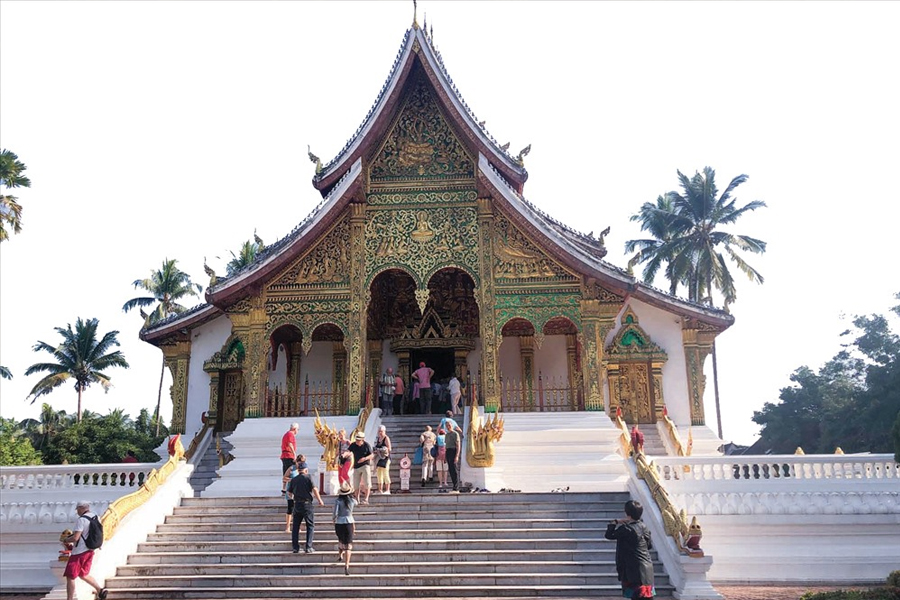
Tourists visiting Haw Pha Bang in the Royal Palace Museum Complex (Cre: Du Lich & Lao Dong Newspaper)
In conclusion, The Royal Palace Museum offers a rich historical experience, allowing visitors to delve into the royal heritage of Laos while enjoying the scenic beauty of Luang Prabang. Be sure not to miss this destination while you’re visiting this UNESCO Heritage City. If you are interested in visiting the Royal Palace Museum, reach out to Asia King Travel now to plan your trip today!
You may like: Laos Tours 5 days